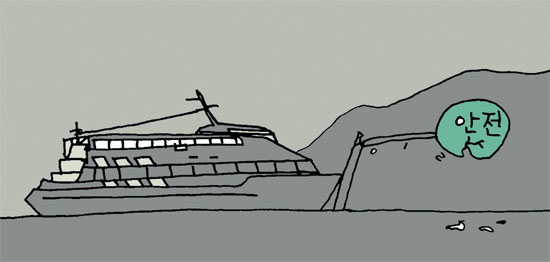Distrust deepens after Sewol tragedy

Since the Sewol disaster, the Korea Coast Guard has been conducting safety inspections on ferryboats in collaboration with the Pohang Regional Maritime and Port Administration. The Dolphin and the 205-ton Dokdo Sarang operating between Ulleung Island and the Dokdo islets were included in the inspection, which took place in late April. Fourteen specialists conducted a two-day evaluation on the two passenger ships, checking evacuation and rescue equipment, making sure the captain and the crew members were trained in the event of an emergency, and ensuring that the navigator, radar, automatic identification system (AIS) and other systems were fully functional.
The Dokdo Sarang is suspended from service until May 13, as the captain was not competent enough to steer the ship. The inspectors also found that the crew members of the Dolphin could not properly handle the extinguishers and emergency equipment. Those devices should have been located near the bridge, but were found to be too far out of reach. The Dolphin was directed to correct this.
Still, it had engine trouble at sea. Passengers were terrified, especially because the incident happened so soon after the Sewol accident. Fortunately, only one engine failed and the boat returned safely to Ulleung Island. A few passengers were admitted to the Ulleung County Hospital.
The Korea Coast Guard said that during the inspection, it only made sure the engine sounded normal in a test run. The engine malfunction could have been identified, however, in a more thorough checkup.
The Dolphin had a complete assessment on March 18, a month and a half before the incident. The Korean Register of Shipping conducted a midterm checkup, but concluded that there was nothing wrong with the engine. Nevertheless, the boat still experienced trouble.
How then can we explain the accident? The Korean Register of Shipping claims that the engine may have been fully functional, suffering a failure later. But how many citizens will truly believe that? How can we ever really trust the agencies tasked by the authorities with safety inspection?
JoongAng Ilbo, May 7, Page 29
*The author is a national news reporter of the JoongAng Ilbo.
BY KIM YOON-HO










with the Korea JoongAng Daily
To write comments, please log in to one of the accounts.
Standards Board Policy (0/250자)